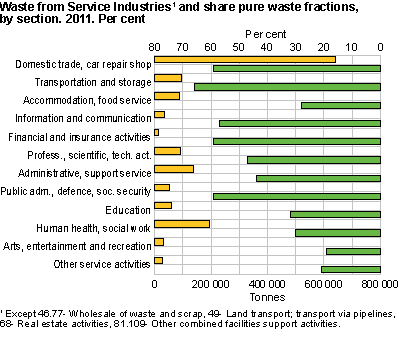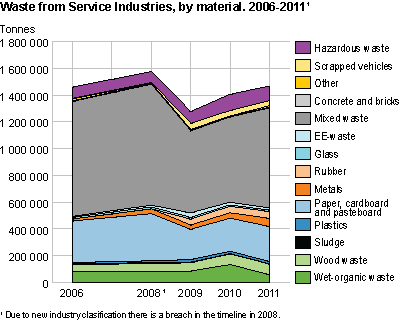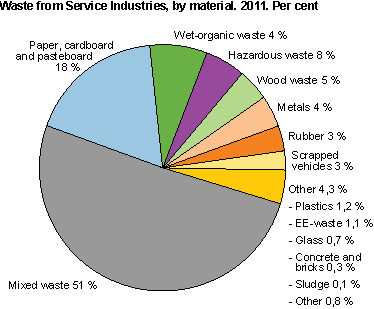Content
Published:
This is an archived release.
Less sorting in the service industries
The service industries generated almost 1.5 million tonnes of waste in 2011. As much as 44 per cent of the waste originated in the domestic trade business. More than half of the waste consisted of mixed waste.
The amount of waste generated by the service industries increased by 6 per cent in 2011 compared to 2010. Almost 640 000 tonnes of waste came from the domestic trade business in 2011, which is almost the same amount as in 2010. Second and third in magnitude are human health and social work services and administrative, support service, with 13 and 9 per cent of the total waste amounts respectively.
Service industriesService industries is a collective term that includes wholesale and retail trade, hotels and restaurants, transport, storage and communication, financial intermediation, real estate, renting and business activities, together with public and personal services. This corresponds to section G-U in the Standard Industrial Classification (SIC2007) . For the time being, the statistics cover section G-S, except 46.77- wholesale of waste and scrap, 49- land transport; transport via pipelines, 68- real estate activities. |
Decrease in wet-organic waste
Despite the general increase in waste amounts, the amount of wet-organic waste that was sorted out as a pure fraction in 2011 is only 4 per cent of the total waste amount, compared to 10 per cent in 2010. This appears to be a general tendency as the same is true for the household waste . This large decrease is probably due to less sorting of food waste in certain regions of Norway, as decided by the waste collectors.
Mostly mixed waste
In 2011, almost 750 000 tonnes, or 51 per cent, was collected as mixed waste. This is a 17 per cent increase compared to 2010. The waste fractions of concrete, metals and hazardous waste have also seen an increase since 2010. The amount of hazardous waste has been steadily increasing by about 10 000 tonnes each year since 2008.
More waste efficient
The waste amounts from the service industries have increased by less than 1 per cent since 2006.
In comparison, the value added (fixed 2005 basic prices) for the industry increased by more than 12 per cent during the same period. This implies that the industry has become more waste efficient over the last five years.
Uncertainty in the figuresThe calculations are based on customer registers from a sample of waste collectors. Some of the customers probably delivered some pure waste fractions to waste collectors outside the sample, or to collectors outside the waste collection business. The total amount of waste and the amount of pure fractions may therefore be too low, while the share of mixed waste may be too high. |
Tables:
Contact
-
Camilla Skjerpen
E-mail: camilla.skjerpen@ssb.no
tel.: (+47) 48 22 72 14
-
Gisle Berge
E-mail: gisle.berge@ssb.no
tel.: (+47) 48 12 19 97



